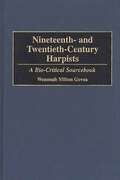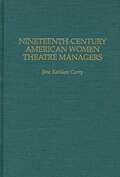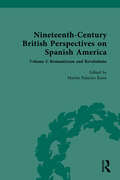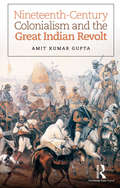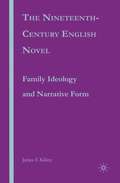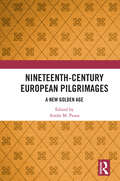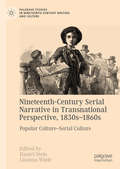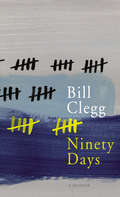- Table View
- List View
Nine Lives: Adolescent Masculinities, The Body And Violence
by James MesserschmidtSociologists and criminologists have long known that there is a relationship between masculinity and crime, for gender has been advanced consistently as the strongest predictor of criminal involvement. Nine Lives, written by one of the most respected authorities on the subject of gender and crime, provides a fascinating account of the connection am
Nine Lives: Adolescent Masculinities, The Body And Violence
by James MesserschmidtSociologists and criminologists have long known that there is a relationship between masculinity and crime, for gender has been advanced consistently as the strongest predictor of criminal involvement. Nine Lives, written by one of the most respected authorities on the subject of gender and crime, provides a fascinating account of the connection am
The Nine Lives of Christmas: The perfect festive read for Christmas 2019
by Florence McNicollIN PARTNERSHIP WITH BATTERSEA DOGS AND CATS HOMECan Battersea's loneliest cat find a home in time for Christmas?It's Christmas at Battersea Dogs and Cats Home and Laura is desperate to find a home for Felicia, a spiky, bad-tempered moggy with a heart of gold. Her boyfriend, Rob, can't understand why she's spending so much time at work, but for Laura, the animals aren't just a job - they're her life. She needs a partner who understands that - doesn't she?As the December snow falls, Laura encounters nine people, all of whom need a little love in their lives and find it in new pets. Everyone needs somebody to curl up with at Christmas, and when the handsome Aaron walks in, he takes not just Felicia, but Laura's heart too...A heart-warming tale about loneliness, love, and the importance of furry friends - perfect to snuggle up with this Christmas.
Nine Paths: A Year in the Life of an Indian Village
by Lexi StadlenRevelatory, lyrical and immersive, this is an extraordinary book that takes you deep into these ordinary women's worlds... Their stories are urgent and forcefully articulated - and this book gives us the chance to hear them.On an island at the eastern edge of India, rural, remote and dense with jungle, is a Muslim village. In an ever-shifting landscape of mangroves and rivers, the women here dwell among contradictions, constrictions and change in a place where one's neighbours are often too close for comfort.Nine Paths follows the lives of nine of these women, and their families, over the course of a year - from one monsoon season to another. There are weddings to celebrate and deaths to mourn, difficult marriages to navigate and tragedies to overcome, as we observe the everyday drudgery and unexpected turmoil, and the dreams of something better. Revelatory, lyrical and immersive, this is an extraordinary book that takes you deep into these ordinary women's worlds. Anthropologist Lexi Stadlen spent sixteen months in this village, talking, listening, and getting to know these women, who were willing to share their complicated, fascinating lives. Their stories are urgent and forcefully articulated - and this book gives us the chance to hear them.
Nineteenth- and Twentieth-Century Harpists: A Bio-Critical Sourcebook (Bio-Critical Sourcebooks on Musical Performance)
by Wenonah M. GoveaThe harp is both the oldest and the newest of instruments. It has existed in some form in nearly all cultures since man has made music. The contemporary concert instrument has been known since the mid-19th century. This work is a compendium of the biographies of many notable harpists of the modern era. The biographies make clear how these performers shaped the contrasts in style and technique of harp playing that have developed over the past 150 years, as cultural, social, and psychological forces influenced individual performance. In addition to the biographical information, the A-Z entries include critical reviews, discographies, and selected bibliographies where possible. New material from the former Soviet states is included.
Nineteenth-Century American Women Theatre Managers (Contributions in Women's Studies)
by Jane K. CurryMany women held positions of great responsibility and power in the United States during the 19th century as theatre managers: managing stock companies, owning or leasing theatres, hiring actors and other personnel, selecting plays for production, directing rehearsals, supervising all production details, and promoting their dramatic offerings. Competing in risky business ventures, these women were remarkable for defying societal norms that restricted career opportunities for women. The activities of more than 50 such women are discussed in Nineteenth-Century American Women Theatre Managers, beginning with an account of 15 pioneering women managers who were all managing theatres before 24 December 1853, when Catherine Sinclair, often incorrectly identified as the first woman theatre manager in the United States, opened her theatre in San Francisco.
Nineteenth-Century American Women Write Religion: Lived Theologies and Literature
by Mary McCartin WearnNineteenth-century American women’s culture was immersed in religious experience and female authors of the era employed representations of faith to various cultural ends. Focusing primarily on non-canonical texts, this collection explores the diversity of religious discourse in nineteenth-century women’s literature. The contributors examine fiction, political writings, poetry, and memoirs by professional authors, social activists, and women of faith, including Elizabeth Stuart Phelps, Angelina and Sarah Grimké, Louisa May Alcott, Rebecca Harding Davis, Harriet E. Wilson, Sarah Piatt, Julia Ward Howe, Julia A. J. Foote, Lucy Mack Smith, Rebecca Cox Jackson, and Fanny Newell. Embracing the complexities of lived religion in women’s culture-both its repressive and its revolutionary potential-Nineteenth-Century American Women Write Religion articulates how American women writers adopted the language of religious sentiment for their own cultural, political, or spiritual ends.
Nineteenth-Century American Women Write Religion: Lived Theologies and Literature
by Mary McCartin WearnNineteenth-century American women’s culture was immersed in religious experience and female authors of the era employed representations of faith to various cultural ends. Focusing primarily on non-canonical texts, this collection explores the diversity of religious discourse in nineteenth-century women’s literature. The contributors examine fiction, political writings, poetry, and memoirs by professional authors, social activists, and women of faith, including Elizabeth Stuart Phelps, Angelina and Sarah Grimké, Louisa May Alcott, Rebecca Harding Davis, Harriet E. Wilson, Sarah Piatt, Julia Ward Howe, Julia A. J. Foote, Lucy Mack Smith, Rebecca Cox Jackson, and Fanny Newell. Embracing the complexities of lived religion in women’s culture-both its repressive and its revolutionary potential-Nineteenth-Century American Women Write Religion articulates how American women writers adopted the language of religious sentiment for their own cultural, political, or spiritual ends.
Nineteenth-Century Anti-Catholic Discourses: The Case of Charlotte Brontë
by D. PeschierBy the middle of the nineteenth century much clearly gendered, anti-Catholic literature was produced for the Protestant middle classes. Nineteenth Century Anti-Catholic Discourses explores how this writing generated a series of popular Catholic images and looks towards the cultural, social and historical foundation of these representations. Diana Peschier places the novels of Charlotte Brontë within the framework of Victorian social ideologies, in particular the climate created by rise of anti-Catholicism and thus provides an alternative reading of her work.
Nineteenth-Century British Perspectives on Spanish America: Volume I: Romanticism and Revolutions
by Marisa Palacios KnoxThe sources in this volume focus on Great Britain’s moral, financial, and diplomatic interventions and ambitions in Latin America. It begins during the wars of independence spanning 1810-1825, when Foreign Secretary George Canning prematurely declared, "Spanish America is free; and if we do not mismanage our affairs sadly, she is English." The independence movements of the former Spanish and Portuguese colonies, as well as their ancient past, inspired Romantic writers such as Anna Letitia Barbauld and spurred British military support and political debate, as attested by mercenary Richard Vowell’s Campaigns and Cruises in Venezuela and James Mill's "Emancipation of Spanish America."
Nineteenth-Century British Perspectives on Spanish America: Volume I: Romanticism and Revolutions
The sources in this volume focus on Great Britain’s moral, financial, and diplomatic interventions and ambitions in Latin America. It begins during the wars of independence spanning 1810-1825, when Foreign Secretary George Canning prematurely declared, "Spanish America is free; and if we do not mismanage our affairs sadly, she is English." The independence movements of the former Spanish and Portuguese colonies, as well as their ancient past, inspired Romantic writers such as Anna Letitia Barbauld and spurred British military support and political debate, as attested by mercenary Richard Vowell’s Campaigns and Cruises in Venezuela and James Mill's "Emancipation of Spanish America."
Nineteenth-Century British Secularism: Science, Religion and Literature (Histories of the Sacred and Secular, 1700-2000)
by Michael RectenwaldNineteenth-Century British Secularism offers a new paradigm for understanding secularization in the nineteenth century. It addresses the crisis in the secularization thesis by foregrounding a nineteenth-century development called 'Secularism' – the particular movement and creed founded by George Jacob Holyoake from 1851 to 1852. Nineteenth-Century British Secularism rethinks and reevaluates the significance of Holyoake's Secularism, regarding it as a historic moment of modernity and granting it centrality as both a herald and exemplar for a new understanding of modern secularity. In addition to Secularism proper, the book treats several other moments of secular emergence in the nineteenth century, including Thomas Carlyle's 'natural supernaturalism', Richard Carlile's anti-theist science advocacy, Charles Lyell's uniformity principle in geology, Francis Newman's naturalized religion or 'primitive Christianity', and George Eliot's secularism and post-secularism.
Nineteenth-Century China: Five Imperialist Perspectives (Michigan Monographs In Chinese Studies #13)
by Dilip BasuMaterials from the past that wrongly anticipate the future, or present information or judgments that are later proved misleading or erroneous, are sometimes overlooked in reconstructing the past. Yet such documents are as legimiate, and perhaps as important, as those that are vindicated by events or continue to share perspectives with later generations. The five documents reproduced in Nineteenth-Century China are typical of the periods from which they come, but each was overtaken or contradicted by events. Collected with a belief in the legitimacy of attempting to see every period as much as possible in its own terms, these texts offer a glimpse of what China looked like and suggested to Englishmen on the spot in Canton and Hong Kong in the first half of the nineteenth century, and how they viewed their own country and its role vis-à-vis the China they observed. The first two texts in Nineteenth-Century China exemplify the imperialist mind’s eagerness to explore the world, to get a picture of all of its parts, and as rapidly as possible to “open” all areas to the benificent influence of the West, notably through an expanded commerce that would enrich its Western masters. Samuel Ball’s “Observations” (1817) show how much detailed information was available to Westerners and what the mercantile British were after, and an anonymous dissertation (1838) provides an example of the dream of the China as El Dorado: an immense population of eager traders, hard workers, and willing buyers. The third text (1845) is an early foreshadowing by a colonial official, R. M. Martin, of Western imperial arguments, rationalizations, and attitudes that would become common fifty years later. The fourth selection consists of an exchange of correspondence in 1847 about British access to and use of land in the vicinity of Canton. A short statement of purpose (1848) from the Morrison Education Society, demonstrating a missionary enterprise combining Christian evangelism and English education, concludes the book.
Nineteenth-Century Colonialism and the Great Indian Revolt
by Amit Kumar GuptaThis book examines the ruptured characteristics of colonialism in nineteenth-century India. It connects the British East India Company’s efforts at the bourgeoisation of India with the Revolt of 1857. The volume shows how the mutiny of Indian sepoys in the British Indian army became a popular uprising of peasants, artisans and discontented aristocrats against the British. Tracing the rationale and consequences of this conflict, the monograph highlights how newly introduced political, economic and agrarian policies as part of industrial Britain’s colonial policy wreaked havoc, resulting in high land revenue assessment and its harsh mode of collection, rural indebtedness, steady immiseration of peasants, widespread land alienation, destitution and suicide. Using rare archival sources, this book will be an important intervention in the study of nineteenth-century India, and will deeply interest scholars and researchers of modern Indian history and politics.
Nineteenth-Century Colonialism and the Great Indian Revolt
by Amit Kumar GuptaThis book examines the ruptured characteristics of colonialism in nineteenth-century India. It connects the British East India Company’s efforts at the bourgeoisation of India with the Revolt of 1857. The volume shows how the mutiny of Indian sepoys in the British Indian army became a popular uprising of peasants, artisans and discontented aristocrats against the British. Tracing the rationale and consequences of this conflict, the monograph highlights how newly introduced political, economic and agrarian policies as part of industrial Britain’s colonial policy wreaked havoc, resulting in high land revenue assessment and its harsh mode of collection, rural indebtedness, steady immiseration of peasants, widespread land alienation, destitution and suicide. Using rare archival sources, this book will be an important intervention in the study of nineteenth-century India, and will deeply interest scholars and researchers of modern Indian history and politics.
The Nineteenth-Century English Novel: Family Ideology and Narrative Form
by J. KilroyThrough analysis of eight English novels of the Nineteenth century, this work explores the ways in which the novel contributes to the formation of ideology regarding the family, and, conversely, the ways in which changing attitudes toward the family shape and reshape the novel.
Nineteenth-Century European Pilgrimages: A New Golden Age
by Antón M. PazosDuring the Nineteenth-Century a major revival in religious pilgrimage took place across Europe. This phenomenon was largely started by the rediscovery of several holy burial places such as Assisi, Milano, Venice, Rome and Santiago de Compostela, and subsequently developed into the formation of new holy sites that could be visited and interacted with in a wholly Modern way. This uniquely wide-ranging collection sets out the historic context of the formation of contemporary European pilgrimage in order to better understand its role in religious expression today. Looking at both Western Catholic and Eastern Orthodox Europe, an international panel of contributors analyse the revival of some major Christian shrines, cults and pilgrimages that happened after the rediscovery of ancient holy burial sites or the constitution of new shrines in locations claiming apparitions of the Virgin Mary. They also shed new light on the origin and development of new sanctuaries and pilgrimages in France and the Holy Land during the Nineteenth Century, which led to fresh ways of understanding the pilgrimage experience and had a profound effect on religion across Europe. This collection offers a renewed overview of the development of Modern European pilgrimage that used intensively the new techniques of organisation and travel implemented in the Nineteenth-Century. As such, it will appeal to scholars of Religious Studies, Pilgrimage and Religious History as well as Anthropology, Art, Cultural Studies, and Sociology.
Nineteenth-Century European Pilgrimages: A New Golden Age
by Antón M. PazosDuring the Nineteenth-Century a major revival in religious pilgrimage took place across Europe. This phenomenon was largely started by the rediscovery of several holy burial places such as Assisi, Milano, Venice, Rome and Santiago de Compostela, and subsequently developed into the formation of new holy sites that could be visited and interacted with in a wholly Modern way. This uniquely wide-ranging collection sets out the historic context of the formation of contemporary European pilgrimage in order to better understand its role in religious expression today. Looking at both Western Catholic and Eastern Orthodox Europe, an international panel of contributors analyse the revival of some major Christian shrines, cults and pilgrimages that happened after the rediscovery of ancient holy burial sites or the constitution of new shrines in locations claiming apparitions of the Virgin Mary. They also shed new light on the origin and development of new sanctuaries and pilgrimages in France and the Holy Land during the Nineteenth Century, which led to fresh ways of understanding the pilgrimage experience and had a profound effect on religion across Europe. This collection offers a renewed overview of the development of Modern European pilgrimage that used intensively the new techniques of organisation and travel implemented in the Nineteenth-Century. As such, it will appeal to scholars of Religious Studies, Pilgrimage and Religious History as well as Anthropology, Art, Cultural Studies, and Sociology.
Nineteenth-Century Female Poisoners: Three English Women Who Used Arsenic to Kill
by V. NagyNineteenth-Century Female Poisoners investigates the Essex poisoning trials of 1846 to 1851 where three women were charged with using arsenic to kill children, their husbands and brothers. Using newspapers, archival sources (including petitions and witness depositions), and records from parliamentary debates, the focus is not on whether the women were guilty or innocent, but rather on what English society during this period made of their trials and what stereotypes and stock-stories were used to describe women who used arsenic to kill. All three women were initially presented as 'bad' women but as the book illustrates there was no clear consensus on what exactly constituted bad womanhood.
Nineteenth-Century Fiction and the Production of Bloomsbury: Novel Grounds (Palgrave Studies in Nineteenth-Century Writing and Culture)
by Matthew InglebyThis study explores the role of fiction in the social production of the West Central district of London in the nineteenth century. It tells a new history of the novel from a local geographical perspective, tracing developments in the form as it engaged with Bloomsbury in the period it emerged as the city’s dominant literary zone. A neighbourhood that was subject simultaneously to socio-economic decline and cultural ascent, fiction set in Bloomsbury is shown to have reconceived the area’s marginality as potential autonomy. Drawing on sociological theory, this book critically historicizes Bloomsbury’s trajectory to show that its association with the intellectual “fraction” known as the ‘Bloomsbury Group’ at the beginning of the twentieth century was symptomatic rather than exceptional. From the 1820s onwards, writers positioned themselves socially within the metropolitan geography they projected through their fiction. As Bloomsbury became increasingly identified with the cultural capital of writers rather than the economic capital of established wealth, writers subtly affiliated themselves with the area, and the figure of the writer and Bloomsbury became symbolically conflated.
The Nineteenth-Century Press in the Digital Age (Palgrave Studies in the History of the Media)
by J. MussellJames Mussell provides an accessible account of the digitization of nineteenth-century newspapers and periodicals. As studying this material is essential to understand the period, he argues that we have no choice but to engage with the new digital resources that have transformed how we access the print archive.
Nineteenth-Century Serial Narrative in Transnational Perspective, 1830s−1860s: Popular Culture—Serial Culture (Palgrave Studies in Nineteenth-Century Writing and Culture)
by Daniel Stein Lisanna WieleThis volume examines the emergence of modern popular culture between the 1830s and the 1860s, when popular storytelling meant serial storytelling and when new printing techniques and an expanding infrastructure brought serial entertainment to the masses. Analyzing fiction and non-fiction narratives from the United States, France, Great Britain, Germany, Austria, Turkey, and Brazil, Popular Culture—Serial Culture offers a transnational perspective on border-crossing serial genres from the roman feuilleton and the city mystery novel to abolitionist gift books and world’s fairs.
The Nineties: When Surface Was Depth
by Michael Bracewellthe first clear anatomy of a confused decade, the 1990s – ‘Bracewell, with great verve and style, animates the cultural conversation’, Greil Marcus
Ninety Days: A Memoir Of Recovery
by Bill CleggThe goal is ninety: just ninety clean and sober days to loosen the hold of the addiction that caused Bill Clegg to lose everything. With seventy-three days in rehab behind him he returns to New York and attends two or three meetings each day. It is in these refuges that he befriends essential allies including the seemingly unshakably sober Asa, and Polly, who struggles daily with her own cycle of recovery and relapse. At first, the support is not enough: Clegg relapses for the first time with only three days left, turning his calendar back to day one. Written with uncompromised immediacy, Ninety Days begins where Portrait of an Addict as a Young Man ends - and tells the wrenching story of Bill Clegg's battle to reclaim his life. As any recovering addict knows, hitting rock bottom is just the beginning.
Ninigret, Sachem of the Niantics and Narragansetts: Diplomacy, War, and the Balance of Power in Seventeenth-Century New England and Indian Country
by Julie A. Fisher David J. SilvermanNinigret (c. 1600–1676) was a sachem of the Niantic and Narragansett Indians of what is now Rhode Island from the mid-1630s through the mid-1670s. For Ninigret and his contemporaries, Indian Country and New England were multipolar political worlds shaped by ever-shifting intertribal rivalries. In the first biography of Ninigret, Julie A. Fisher and David J. Silverman assert that he was the most influential Indian leader of his era in southern New England. As such, he was a key to the balance of power in both Indian-colonial and intertribal relations. Ninigret was at the center of almost every major development involving southern New England Indians between the Pequot War of 1636–37 and King Philip’s War of 1675–76. He led the Narragansetts’ campaign to become the region’s major power, including a decades-long war against the Mohegans led by Uncas, Ninigret’s archrival. To offset growing English power, Ninigret formed long-distance alliances with the powerful Mohawks of the Iroquois League and the Pocumtucks of the Connecticut River Valley. Over the course of Ninigret’s life, English officials repeatedly charged him with plotting to organize a coalition of tribes and even the Dutch to roll back English settlement. Ironically, though, Ninigret refused to take up arms against the English in King Philip’s War. Ninigret died at the end of the war, having guided his people through one of the most tumultuous chapters of the colonial era.



